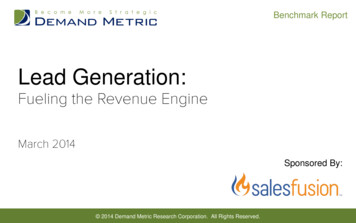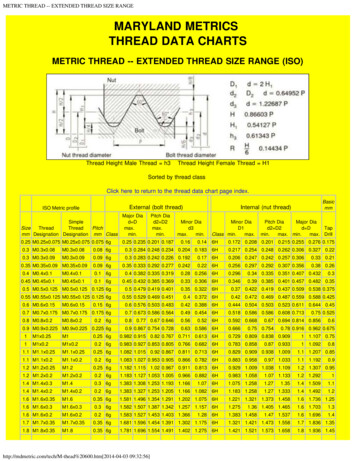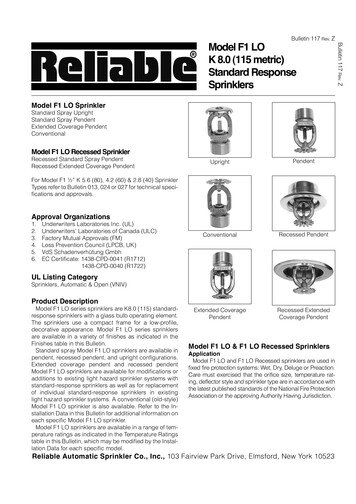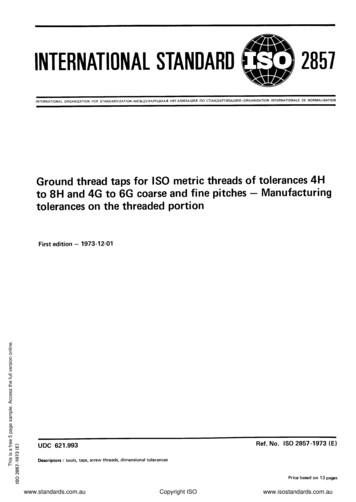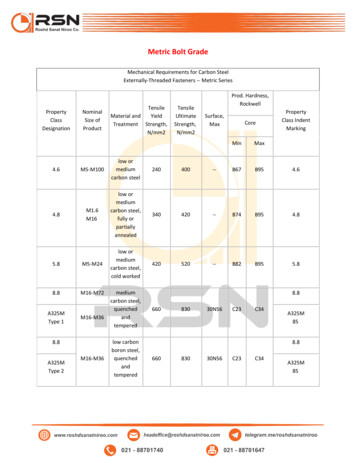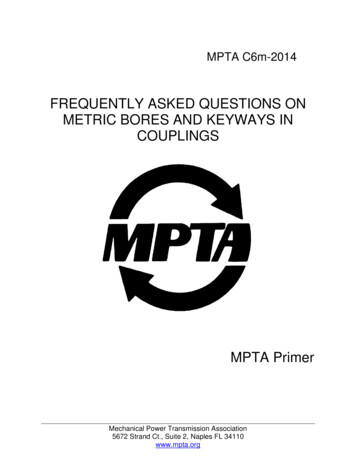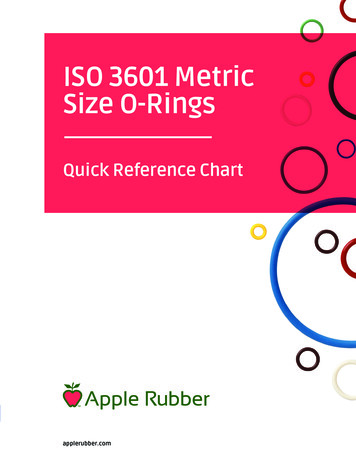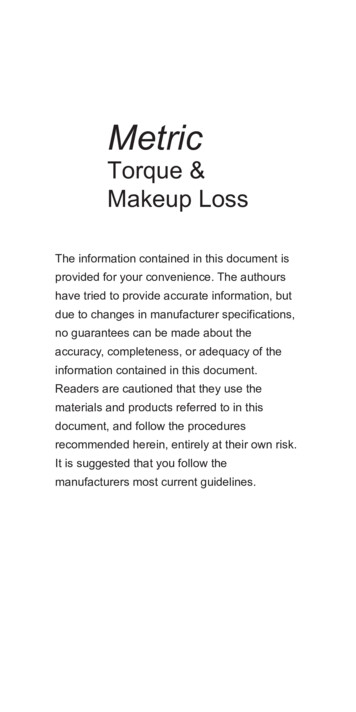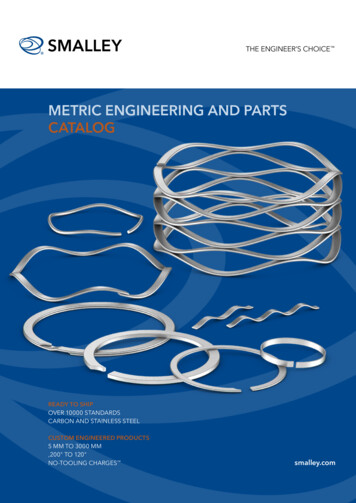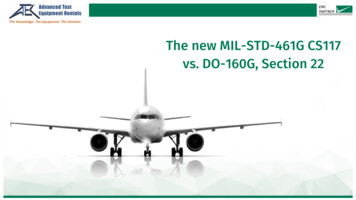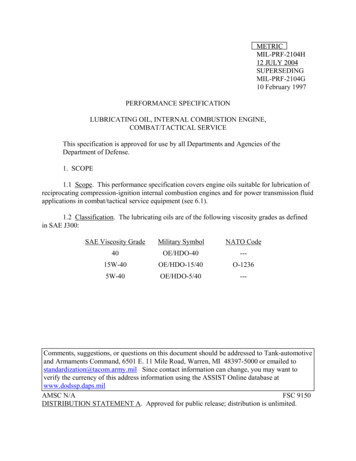
Transcription
METRICMIL-PRF-2104H12 JULY 2004SUPERSEDINGMIL-PRF-2104G10 February 1997PERFORMANCE SPECIFICATIONLUBRICATING OIL, INTERNAL COMBUSTION ENGINE,COMBAT/TACTICAL SERVICEThis specification is approved for use by all Departments and Agencies of theDepartment of Defense.1. SCOPE1.1 Scope. This performance specification covers engine oils suitable for lubrication ofreciprocating compression-ignition internal combustion engines and for power transmission fluidapplications in combat/tactical service equipment (see 6.1).1.2 Classification. The lubricating oils are of the following viscosity grades as definedin SAE J300:SAE Viscosity GradeMilitary SymbolNATO HDO-5/40---Comments, suggestions, or questions on this document should be addressed to Tank-automotiveand Armaments Command, 6501 E. 11 Mile Road, Warren, MI 48397-5000 or emailed tostandardization@tacom.army.mil Since contact information can change, you may want toverify the currency of this address information using the ASSIST Online database atwww.dodssp.daps.milAMSC N/AFSC 9150DISTRIBUTION STATEMENT A. Approved for public release; distribution is unlimited.
MIL-PRF-2104H2. APPLICABLE DOCUMENTS2.1 General. The documents listed in this section are specified in sections 3 and 4 of thisspecification. This section does not include documents cited in other sections of thisspecification or recommended for additional information or as examples. While every effort hasbeen made to ensure the completeness of this list, document users are cautioned that they mustmeet all specified requirements documents cited in sections 3 and 4 of this specification, whetheror not they are listed.2.2 Government documents.2.2.1 Specifications, standards, and handbooks. The following specifications, standards,and handbooks form a part of this document to the extent specified herein. Unless otherwisespecified, the issues of these documents are those listed in the issue of the Department ofDefense Index of Specifications and Standards (DoDISS) and supplement thereto, cited in thesolicitation (see 6.2 and 6.6).INTERNATIONAL STANDARDIZATION AGREEMENTSSTANAG 1135- Fuels, Oils, Lubricants and Petroleum Handling Equipment.(Copies of this document are available online at http://assist.daps.dla.mil/quicksearch/ orwww.dodssp.daps.mil or from the Standardization Document Order Desk, 700 Robbins Avenue,Building 4D, Philadelphia, PA 19111-5094.)2.2.2 Other Government documents, drawings, and publications. The following otherGovernment documents, drawings, and publications form a part of this specification to the extentspecified herein. Unless otherwise specified, the issues are these documents cited in thesolicitation or contract.U.S. ARMY RESEARCH, DEVELOPMENT AND ENGINEERING COMMANDGuide for the Qualification of Engine and Gear Lubricants.(Copies of the guide may be obtained from USA RDE Command,ATTN: AMSRD-TAR-D (MS-110), 6501 E. 11 Mile Road, Warren, MI 48397-5000.)2.3 Non-Government publications. The following documents form a part of thisdocument to the extent specified herein. Unless otherwise specified, the issues of thesedocuments are those cited in the solicitation or contract.2
MIL-PRF-2104HASTM INTERNATIONALASTM D 92ASTM D 97ASTM D 130ASTM D 287ASTM D 445ASTM D 874ASTM D 892ASMT D 4485ASTM D 4629ASTM D 4683ASTM D 4684ASTM D 5185ASTM D 5293ASTM D 5800ASTM D 5862ASTM D 5950- Flash and Fire Points by Cleveland Open Cup, Standard TestMethod (DoD adopted).- Pour Point of Petroleum Products, Standard Test Method(DoD adopted).- Detection of Copper Corrosion from Petroleum Products by theCopper Strip Tarnish, Standard Test Method (DoD adopted).- API Gravity of Crude Petroleum and Petroleum Products,(Hydrometer Method), Standard Test Method (DoD adopted).- Kinematic Viscosity of Transparent and Opaque Liquids(and the Calculation of Dynamic Viscosity), Standard TestMethod (DoD adopted).- Sulfated Ash, from Lubricating Oils and Additives, StandardTest Method (DoD adopted).- Foaming Characteristics of Lubricating Oils, Standard TestMethod (DoD adopted).- Standard Specification for Performance of Engine Oils.- Trace Nitrogen in Liquid Petroleum Hydrocarbons bySyringe/Inlet Oxidative Combustion and ChemiluminescenceDetection, Standard Test Method (DoD adopted).- Measuring Viscosity at High Shear Rate and High Temperatureby Tapered Bearing Simulator, Standard Test Method.- Determination of Yield Stress and Apparent Viscosity ofEngine Oils at Low Temperature, Standard Test Method(DoD adopted).- Determination of Additive Elements, Wear Metals, andContaminants in Used Lubricating Oils and Determination ofSelected Elements in Base Oils by Inductively Coupled PlasmaAtomic Emission Spectrometry (ICP-AES), Standard TestMethod (DoD adopted).- Apparent Viscosity of Engine Oils Between -5 and-35 Degrees C Using the Cold-Cranking Simulator, StandardTest Method.- Evaporation Loss of Lubricating Oils by the Noack Method,Standard Test Method.- Evaluation of Engine Oils in Two-Stroke Cycle TurboSupercharged 6V92TA Diesel Engine, Standard Test Method.- Pour Point of Petroleum Products (Automatic Tilt Method),Standard Test Method.3
MIL-PRF-2104HASTM D 5966 - Evaluation of Engine Oils for Roller Follower Wear in LightDuty Diesel Engine, Standard Test Method.ASTM D 5967 - Evaluation of Diesel Engine Oils in T-8 Diesel Engine,Standard Test Method.ASTM D 6278 - Shear Stability of Polymer Containing Fluids Using aEuropean Diesel Injector Apparatus, Standard Test Method.ASTM D 6594 - Evaluation of Corrosiveness of Diesel Engine Oil at135 Degrees C, Standard Test Method.ASTM D 6750 - Evaluation of Engine Oils in a High-Speed, Single-CylinderDiesel Engine 1K Procedure (0.4% Fuel Sulfur) and 1NProcedure (0.04% Fuel Sulfur), Standard Test Method.ASTM D 6894Evaluation of Aeration Resistance of Engine Oils in DirectInjected Turbocharged Automotive Diesel Engine, StandardTest Method.ASTM D 6922 - Determination of Homogeneity and Miscibility in AutomotiveEngine Oils, Standard Test Method.ASTM D 6975 - Cummins M11 EGR, Standard Test Method.ASTM D 6984 - Evaluation of Automotive Engine Oils in the Sequence IIIF,Spark-Ignition Engine, Standard Test Method.ASTM D 6987 - Evaluation of Engine Oils in the T-10 Exhaust GasRecirculation Diesel Engine, Standard Test Method.ASTM RR D02-1379 - Global Engine Oil Service Specification DHD-1Characteristic, Standard Test Method.ASTM RR D02-1517 - Research Report for Mini-Rotary Viscosity and YieldStress of Highly Sooted Diesel Engine Oils, StandardTest Method.(Copies of these documents are available from ASTM International, 100 Barr HarborDrive, West Conshohocken, PA 19428-2959 or website: http:/www.astm.org)ALLISON TRANSMISSION DIVISION (ATD)/GENERAL MOTORS CORPORATION (GM)C-4GMN10055- Heavy-Duty Automatic Transmission Fluid Specification(TES-228).- DEXRON -III, H revision, Automatic Transmission FluidSpecification.(Copies of these documents are available from Southwest Research InstituteC4 Coordinator, Specialty and Driveline Fluids Lab, P.O. Box 28510, San Antonio,TX 78223-0510, or website: www.swri.org)4
MIL-PRF-2104HCATERPILLAR INC., ENGINE DIVISION (CAT.)TO-4/TO-4M- Transmission and Drive Train Fluid Requirements.(Copies of these documents are available from Caterpillar Inc., Corporate FluidsEngineering, Mail Code: H2000, P.O. Box 610, Mossville, IL 61552-0610.)PERFORMANCE REVIEW INSTITUTE (PRI)Procedures of the Engine Oil Review Committee(Copies of these documents are available from Secretary of the Lubricants ReviewInstitute (LRI), Performance Review Institute, 161 Thornhill Road, Warrendale, PA 15086-7527or website: www.pri.sae.org)SOCIETY OF AUTOMOTIVE ENGINEERS (SAE)SAE J300- Engine Oil Viscosity Classification.(Copies of these documents are available from SAE World Headquarters,400 Commonwealth Drive Warrendale, PA 15096-0001 USA, or website: www.sae.org)2.4 Order of precedence. In the event of a conflict between the text of this document andthe references cited herein, the text of this document takes precedence. Nothing in thisdocument, however, supersedes applicable laws and regulations unless a specific exemption hasbeen obtained.3. REQUIREMENTS3.1 Qualification. The lubricating oils furnished under this specification shall beproducts that are authorized by the qualifying activity for listing on the applicable qualifiedproducts list before contract award (see 4.1.1 and 6.3). Any change in the formulation of aqualified product will necessitate its requalification.3.2 Design, materials, and manufacturing processes. Unless otherwise specified, thedesign, materials and manufacturing process selection is the prerogative of the contractor as longas all articles submitted to the Government fully meet the operating, interface, support andownership, and environmental requirements specified.3.2 1 Materials. Lubricating oils shall be derived from petroleum fractions, syntheticallyprepared compounds or a combination of the two types of products. They may be virgin,re-refined stocks or a combination thereof. The stocks shall be compounded with suchfunctional additives (detergents, dispersants, oxidation inhibitors, corrosion inhibitors, etc) as arenecessary to meet the specification requirements.5
MIL-PRF-2104H3.2.2 Recycled, recovered, or environmentally preferable materials. Recycled,recovered, or environmentally preferable materials should be used to the maximum extentpossible provided that the material meets or exceeds the operational and maintenancerequirements, and promotes economically advantageous life cycle costs.3.3 Operating requirements. The lubricating oil shall meet all the finished oil andoperating requirements as specified in 3.3.1 through 3.3.16 and conform to the rheological andphysical requirements specified in Table I.TABLE I. Finished oil requirements.PropertySAE Grade SAE Grade4015W-401oKinematic viscosity, cSt @ 100 C min.12.512.5max. 16.3 16.3Low temperature crankingmin.---7000@-25viscosity, cP2 @ oCmax.---7000@-20SAE Grade5W-4012.5 16.36200@-356600@-30High-temperature/high-shear viscosity, cP, @150ºC min.Low temperature pumping viscosity, cP @ oC, max.----3.73.7----60 000@-2560 000@-35Pour point, ºC, max.-15-25-40Flash point, ºC, min.225215210Evaporative loss, %, max.----1515Sulfated ash, %, max.NOTES: 1. cSt mm2/s2. cP mPa*s1.51.51.53.3.1 Foaming/aeration. All grades of oils shall meet the oil foaming/aeration propertiesof Table II and IIA, reducing the potential for loss of oil pressure and the associated malfunctionor damage of oil operated and lubricated components (see 4.3.3.1).TABLE II. Properties of foaming.Rated or measured parameterPrimary performance criteriaSequence I, foam/settling, mL, max.10/0Sequence II, foam/settling, mL, max.20/0Sequence III, foam/settling, mL, max.10/06
MIL-PRF-2104HTABLE IIA. Properties of aeration.Rated or Measured ParameterPrimary performance criteriaAeration (EOAT), volume, %, max.8.0 (MTAC)1NOTE: Multiple Test Acceptance Criteria (MTAC) is a data-based approach for evaluation ofthe quality and performance of a formulation where more than one test may be run. SeeASTM D 4485, Annex A1 for additional information.3.3.2 Shear stability. Multi-viscosity oils shall resist permanent viscosity loss from highshear conditions in accordance with Table III, particularly those containing polymeric viscositymodifiers (see 4.3.3.2).TABLE III. Shear stability performance.Rated or measured parameterPrimary performance criteriaKinematic viscosity after12.5shearing, cSt, min.3.3.3 Piston deposits and scuffing control. All grades of oils shall prevent the buildup ofaluminum and/or steel ring belt deposits, including those of the piston crown and lands, pistonring grooves, piston undercrown and piston skirts in accordance with Table IV (see 4.3.3.3).TABLE IV. Piston deposits and scuffing performance.MaterialRated or measured parameterWeighted Piston Demerits (WDK), max.AluminumTop Groove Fill (TGF), %, max.242729Top Land Heavy Carbon (TLHC), %, max.4550.50.50.5NoneNoneNoneWeighted Piston Demerits (WDP), max.350378390Top Groove Carbon (TGC), demerits, max.363941Top Land Carbon (TLC), demerits, max.404649Average Oil Consumption, (0-360 h), g/h, max.12.412.412.4Final Oil Consumption, (312-360 h), g/h, max.14.614.614.6Piston, Ring, and Liner ScuffingNoneNoneNoneAverage Oil Consumption, g/kW-h (see note), max.Piston, Ring, and Liner ScuffingSteelPrimary performance criteriaOne-Test Two-TestThree-Test332347353NOTE: g/kW-h, grams per kilowatt hour.3.3.4 Sludge control, filterability and sliding valvetrain wear protection. All grades ofoils shall prevent the formation and accumulation of sludge, keeping these deposits adequatelydispersed, in accordance with Table V so not to induce filter plugging or excessively high filterdelta pressure. Furthermore, all grades of oils shall minimize the wear of valvetrains designedwith sliding contacts (see 4.3.3.4).7
MIL-PRF-2104HTABLE V. Properties of sludge control, filterability and sliding valvetrain wear.Primary performance criteriaRated or measured parameterOne-testTwo-testThree-testAvg. crosshead weight loss, milligrams (mg), max.20.021.822.6Avg. top ring weight loss, mg, max.175186191Oil filter delta pressure, @ 250 h, kPa, max.275320341Avg. engine sludge, Coordinating ResearchCouncil (CRC) merits, min.7.87.67.53.3.5 Soot control. All grades of oils shall minimize the viscosity increase and filterplugging tendency in accordance with Table VI due to high soot loading (see 4.3.3.5).TABLE VI. Properties of soot control.Primary performance criteriaRated or measured parameterOne-testTwo-testThree-testRelative viscosity at 4.8% soot, max.1.81.92.0NOTE: Relative viscosity (viscosity at 4.8 % soot) (viscosity of new oil sheared inASTM D 6278).3.3.6 Used oil pumpability. Lubricating oil shall minimize the effects of combustionblow-by products, soot accumulation, and other in-service contaminants in accordance withTable VII, on used oil pumpability (see 4.3.3.6).TAB
in SAE J300: SAE Viscosity Grade Military Symbol NATO Code 40 OE/HDO-40 --- 15W-40 OE/HDO-15/40 O-1236 5W-40 OE/HDO-5/40 --- Comments, suggestions, or questions on this document should be addressed to Tank-automotive and Armaments Command, 6501 E. 11 Mile Road, Warren, MI 48397-5000 or emailed to standardization@tacom.army.mil Since contact information can change, you may
